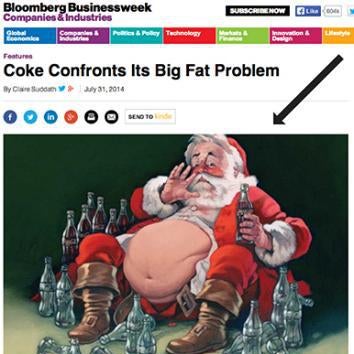This week in Bloomberg Businessweek, staff writer Claire Suddath takes a close look at the evolving business strategy of Coca-Cola North America, which has seen consumer demand fall as more and more people realize that drinking Coke is really bad for them. The company’s strategy involves buying other beverage brands with healthier images, experimenting with smaller portion sizes, and letting its president admit to reporters that he drinks only one Coke a day (rather than, I suppose, pretending that he subsists on Coke and Coke alone). Suddath’s story is a fascinating, nuanced look at how America’s changing preferences play out in the marketplace.
The cover image and illustration that accompany Suddath’s article, though? Not so nuanced. The cover of this week’s magazine features a potbellied Coca-Cola bottle saying, “Would You Believe I’m Just Big-Boned?” The inside illustration is of a morbidly obese Santa Claus—Coca-Cola’s classic mascot—surrounded by empty Coke bottles, his paunch bursting out of his red suit, looking up at the viewer in shame. These images are better than the “headless fatty,” the lazy art director’s usual dehumanizing choice for illustrating articles about obesity—but not by much.
The cover image might seem benign because it depicts an object, rather than an actual person, but its implications are troubling. Coca-Cola bottles are all the same. Well, not literally—there are 12-ounce bottles and 20-ounce bottles and 62-ounce bottles, but each 20-ounce bottle is factory-made to be identical to every other 20-ounce bottle. A bottle that bulges like the one on the cover of Businessweek is defective. Human bodies are not all the same—some of them are tall, some are round, some are bony—and none of these differences are defects. The visual analogy on Businessweek’s cover implies that fatness is some kind of deformity, which is not exactly the most compassionate message to send to people whose bodies look like the rotund Coke bottle.

The illustration accompanying the story on the inside of the magazine sends an even worse message. Santa, we deduce from the image, is morbidly obese because he can’t stop drinking Coke. The notion that fat people just lack willpower, and that they’re victims of their own impulsiveness, is pervasive but false. Being fat is not a moral failing; it’s simply the most visible result of the complex interplay between genetics, environment, and personal history. And fat people needn’t feel “helpless, almost sad” about their bodies, as one Businessweek staffer approvingly described Santa in the illustration. The main thing that makes people feel helpless and sad about obesity is societal stigma, which is just what Businessweek’s illustration reinforces.
Apart from stigmatizing its readers—and, assuming they’re anything like the U.S. population at large, Businessweek’s readers include a lot of fat people—Businessweek’s choice of images confuses the issue at hand. The problem with Coke is not that it makes people fat; it’s that it makes people sick. (Contrary to popular belief, being overweight doesn’t always mean being unhealthy.) Granted, it’s a lot more difficult to convey diabetes or heart disease in a single clear, catchy cover image than it is to lampoon fat bodies, but Businessweek could have at least tried. (The magazine’s “look at how this week’s cover got made” reveals just how little empathy went into the evolution of the fat Coke bottle and fat Santa. “This looks great,” wrote one anonymous Businessweek editor or art director to the CGI artist who designed the bottle, “The flab is looking very realistic. The butt is a nice touch. Could we make it even fatter?”)
No doubt, Businessweek’s editors meant to poke fun at Coca-Cola with the cover and inside illustration. Too bad they had to insult some of their readers along the way.